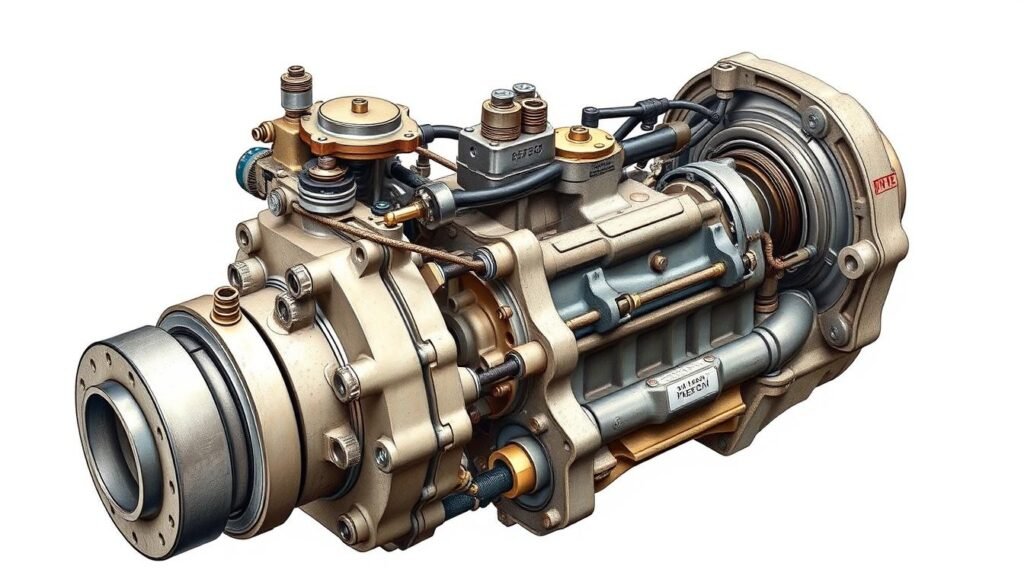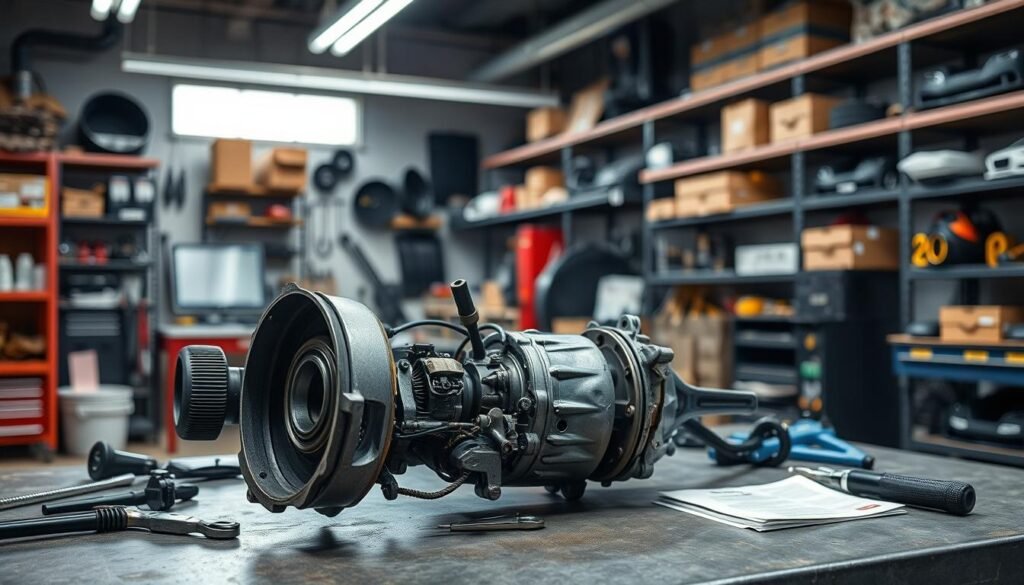Are you aware of the critical role the steering box plays in your vehicle’s handling and safety performance? A faulty steering system can lead to a loss of control, compromising your safety on the road.
The steering gear box is a vital component that transforms the steering wheel turns into rotation, utilizing high-pressure hydraulic fluid from the power steering pump to provide assistance in turning the wheels.
Understanding common steering box problems and their impact on your certified pre-owned vehicle is crucial for maintaining smooth handling and preventing costly repairs.
Key Takeaways
- Common steering box issues that affect driving experience and vehicle control.
- The importance of proper maintenance for the steering system.
- How steering box performance impacts overall driving comfort.
- The relationship between steering box issues and vehicle value.
- The role of certified pre-owned vehicle warranties in covering steering system repairs.
Understanding Steering Systems in Certified Pre-Owned Vehicles
Understanding the intricacies of steering systems in certified pre-owned vehicles can significantly enhance your driving experience. The steering system is a complex assembly of components that work together to provide the necessary control and maneuverability. At its core, the steering system is responsible for translating the driver’s input into the desired vehicle movement.
The Critical Role of the Steering Box
The steering box, also known as the steering gear, is a critical component of the steering system. It is responsible for converting the rotational motion of the steering wheel into the linear motion needed to turn the vehicle’s wheels. A faulty steering box can lead to reduced steering precision and increased driver fatigue. In certified pre-owned vehicles, the condition of the steering box is a significant factor in determining the overall quality of the steering.
How Power Steering Systems Function
Power steering systems use high-pressure hydraulic fluid from the power steering pump to assist in turning the wheels. This assistance is particularly beneficial in heavy vehicles or when maneuvering at low speeds. The power steering fluid plays a crucial role in the functioning of the system, and maintaining the proper fluid levels is essential. A comparison of traditional hydraulic power steering and modern electric power steering systems is shown in the table below.
| Feature | Hydraulic Power Steering | Electric Power Steering |
|---|---|---|
| Assistance Mechanism | Hydraulic fluid pressure | Electric motor |
| Fuel Efficiency | Generally less efficient | More fuel-efficient |
| Maintenance | Requires fluid checks | Less maintenance-intensive |
Identifying Steering Box Problems in Your Vehicle
Recognizing the signs of steering box wear is essential for preventing more severe issues down the road. Your vehicle’s steering system is complex, and the steering box plays a critical role in its operation. Being able to identify potential problems early can save you time and money.
Warning Signs While Driving
While driving, you might notice certain signs that indicate steering box problems. Pay attention to any unusual noises, such as clunking or grinding sounds when you turn the steering wheel. Additionally, if your vehicle pulls to one side or the steering feels loose, it could be a sign of steering gear wear. You should also be aware of any vibrations in the steering wheel, as this can indicate issues with the power steering fluid or the steering box itself.
To inspect your steering system, start by checking the power steering fluid level. Low fluid levels can cause problems with the steering, so it’s essential to top it off as needed. You should also look for any signs of fluid leaks around the steering box, as this can indicate deteriorating seals.
Visual Indicators of Steering Gear Wear
A few visual indicators can help verify if the steering gearbox is worn out. Have a helper sit in the driver’s seat and wiggle the steering wheel back and forth a few inches. You should be able to see the steering shaft rotating slightly. If you notice the input shaft moves back and forth with no movement from the pitman arm, the play is coming from inside the steering box, and it will need attention.
- Check for side-to-side play in the sector shaft where the pitman arm attaches; it should not move back and forth at all, only rotate.
- Inspect the steering linkage connections for excessive movement or wear that might indicate steering gear problems.
- Look for uneven tire wear patterns that might be caused by steering gear issues.

By following these steps, you can identify potential steering box problems early and take corrective action to maintain your vehicle’s performance and safety.
Diagnosing Steering Issues in Certified Pre-Owned Vehicles
Diagnosing steering issues in your certified pre-owned vehicle is crucial for maintaining its performance and safety. Steering problems can manifest in various ways, from subtle vibrations to significant difficulties in turning the steering wheel. Early detection is key to preventing further damage and ensuring your vehicle remains in good condition.
Basic Inspection Techniques Anyone Can Perform
You can start by performing some basic inspections. Check the steering fluid level and condition. Look for any signs of leaks around the steering system components. Inspect the wheel alignment and check for uneven tire wear, which can be a sign of steering issues.
- Check the steering fluid level and top it off if necessary.
- Inspect the steering system for any signs of wear or damage.
- Look for uneven tire wear patterns.
Road Testing to Confirm Steering Problems
A road test is essential to diagnose steering issues accurately. Take your vehicle for a drive on different road surfaces and pay attention to any unusual noises, vibrations, or difficulty in turn steering. Perform various maneuvers such as gentle turns, lane changes, and straight-line driving to assess the steering performance.
During the test, notice how the vehicle responds to your inputs. If the steering wheel is unresponsive or if you experience grinding or whining noises when turning, it may indicate a problem with the steering box or other components.
Step-by-Step Steering Box Diagnosis Guide
Understanding how to diagnose steering box problems can save you time and money in the long run. Diagnosing issues with your vehicle’s steering box is a straightforward process if you have the right tools and follow the correct steps.
Essential Tools for Proper Diagnosis
To diagnose steering box problems effectively, you’ll need a few essential tools. These include a socket set, a wrench set, and a helper to assist with the inspection process. Having the right tools will make it easier to identify potential issues and determine the best course of action.
Safety Precautions Before You Begin
Before starting the diagnosis, ensure your vehicle is safely positioned on a level surface and apply the parking brake. It’s also crucial to turn off the engine and engage the steering wheel lock to prevent any accidental movements. Safety should always be your top priority when working with your vehicle.
Complete Inspection Process Walkthrough
To inspect the steering box, start by checking the steering wheel free play. Have a helper wiggle the steering wheel back and forth a few inches while you observe the steering shaft. If you notice the input shaft moves back and forth with no movement from the pitman arm, the play is likely coming from inside the steering box. Additionally, inspect the sector shaft for any side-to-side play, as it should only rotate, not move back and forth.
Other key steps in the inspection process include checking the steering column and intermediate shaft connections for wear or looseness, verifying the steering box mounting bolts are properly torqued, and testing the pitman arm connection for excessive play. By following these steps, you’ll be able to systematically diagnose steering box problems and identify the root cause of any issues.
Steering Box Replacement Options for Your Vehicle
If your certified pre-owned vehicle’s steering box is malfunctioning, you’ll need to weigh the pros and cons of different replacement options. Replacing a faulty steering box can significantly impact your vehicle’s performance and safety.
OEM vs. Remanufactured Steering Boxes
When it comes to replacing your steering box, you have the option of choosing between an Original Equipment Manufacturer (OEM) steering box and a remanufactured one. OEM steering boxes are made by the same manufacturer that produced the original steering box for your vehicle, ensuring a precise fit and function.
Remanufactured steering boxes, on the other hand, are rebuilt using a combination of used and new parts. They can offer a cost-effective alternative to OEM boxes while still providing reliable performance. However, the quality can vary depending on the remanufacturer.

Premium Steering Box Upgrades for Enhanced Performance
If you’re looking to enhance your vehicle’s steering performance beyond the original factory specifications, consider premium steering box upgrades. One such option is Red-Head Steering Gears, which are technically remanufactured but offer significant improvements over the original equipment.
Red-Head Steering Gears are rebuilt with high-quality components, including needle bearings instead of bushings for the shafts and precision ball bearings. This results in a smoother and tighter steering feel, enhancing your overall driving experience.

Upgrading to a premium steering box can provide several benefits, including tighter steering response and better road feel. These upgrades are particularly beneficial for drivers who prioritize performance and handling.
DIY Steering Box Replacement: A Comprehensive Guide
Replacing a steering box can seem daunting, but with the right guidance, it’s a manageable DIY project. This guide will walk you through the process, ensuring you have the knowledge to replace your steering box efficiently.
Required Tools and Materials Checklist
Before starting, it’s essential to have the right tools and materials. You’ll need a new steering box, a pitman arm, and the necessary tools for removal and installation, such as wrenches and a puller. Ensure you have power steering fluid on hand to fill the reservoir during the bleeding process.
Having everything ready will make the process smoother and less stressful. Check your vehicle’s manual for specific requirements and recommendations.
Removal Process: Step-by-Step Instructions
The removal process involves several key steps. First, disconnect the pitman arm from the steering linkage. Then, remove the steering box mounting bolts and carefully take out the old box. Be mindful of the surrounding components to avoid damage.
Once the old box is removed, inspect the area for any signs of wear or damage that may need attention before installing the new gear box.
Installation, Adjustment, and System Bleeding Procedures
To install the new steering box, first center it by turning the input shaft from end to end and counting the turns. Then, attach the new pitman arm to the sector shaft. The installation is largely the reverse of removal, but you’ll need to bleed the air system afterward.
Fill the reservoir with new power steering fluid, and with the front tires still in the air, slowly turn the steering wheel back and forth several times. Monitor the fluid level to prevent the reservoir from going dry. This process removes air from the system, ensuring smooth operation.

After completing the installation and bleeding the system, check for any leaks and verify that the steering box is functioning correctly. A road test will help confirm that the replacement was successful and that your vehicle’s steering is responsive and smooth.
When to DIY vs. When to Seek Professional Help
As you navigate steering box problems, understanding when to take matters into your own hands and when to consult an expert is vital. Your decision to DIY or seek professional help for steering system repairs depends on several factors.
Assessing Your Mechanical Skill Level
Before attempting any repairs, assess your mechanical skill level honestly. If you’re comfortable with basic car maintenance and have experience with steering gear components, you might be able to handle simpler tasks. However, if you’re unsure or lack experience, it’s best to seek help.
Finding a Qualified Steering System Specialist
When looking for a professional, consider specialists who focus on steering and suspension systems for your truck. Look for certifications and reviews that indicate expertise. You’ll want to understand the breakdown of parts and labor costs and ensure that the mechanic can effectively communicate the diagnosis and repair plan. At the right time, consulting a certified mechanic can save you from further complications with your vehicle’s system.
Preventative Maintenance to Avoid Future Steering Box Problems
Regular maintenance and mindful driving habits can significantly extend the life of your vehicle’s steering system. By understanding how your daily driving habits impact your certified pre-owned vehicle’s steering box, you can take proactive steps to prevent future problems.
Regular Fluid Checks and Maintenance Schedule
To maintain your vehicle’s steering system, regular fluid checks are crucial. Ensure that the power steering fluid level is at the recommended level, as specified in your vehicle’s manual. A maintenance schedule should include checking the fluid condition and topping it off as necessary.Neglecting fluid checks can lead to premature wear on the steering box and other components.
| Maintenance Task | Frequency | Importance |
|---|---|---|
| Power Steering Fluid Check | Every 5,000 miles | High |
| Steering System Inspection | Every 10,000 miles | High |
| Fluid Replacement | As recommended by manufacturer | Medium |
Driving Habits That Extend Steering System Life
Your driving habits significantly impact the lifespan of your vehicle’s steering box. Avoiding extreme steering maneuvers, such as turning the wheel lock-to-lock while stationary, can reduce unnecessary wear. Proper weight distribution and avoiding vehicle overloading also reduce stress on steering components.
By adopting smooth steering inputs and managing your speed when encountering road hazards, you can prevent damage to the steering system. Additionally, allowing your vehicle to warm up properly in cold weather benefits the steering system’s longevity. Being mindful of these factors can help you avoid premature wear on your steering box.
Protecting Your Investment in a Certified Pre-Owned Vehicle
Protecting your investment in a certified pre-owned vehicle involves more than just regular maintenance; it requires attention to critical components like the steering system. By doing so, you’re not just maintaining its value; you’re ensuring a safer and more enjoyable driving experience.
The steering box is a crucial part of this system. Regular checks, such as monitoring the fluid level and inspecting for play in the wheel, can help identify potential issues early. Addressing steering problems promptly can prevent damage to related components and more expensive repairs down the line.
By documenting all steering system maintenance and repairs, you can enhance your vehicle’s resale value. A comprehensive maintenance plan that includes regular professional inspections will help you identify potential steering problems before they become serious, safeguarding your investment and ensuring your vehicle’s longevity.
FAQ
What are the common signs of a faulty steering gear?
Common signs include difficulty turning the wheel, loose or stiff steering, and unusual noises when turning. You may also notice vibrations or play in the steering wheel.
How often should I check my power steering fluid level?
It’s recommended to check your power steering fluid level every time you check your engine oil or during routine maintenance. Low fluid levels can cause steering issues.
Can I drive my vehicle with a faulty steering gearbox?
While you can still drive your vehicle, a faulty steering gearbox can lead to reduced control and increased risk of an accident. It’s best to have it inspected and repaired as soon as possible.
What’s the difference between an OEM and a remanufactured unit?
An OEM (Original Equipment Manufacturer) steering gearbox is brand new, while a remanufactured unit is rebuilt to original specifications. Both can be reliable options, but remanufactured units are often more cost-effective.
How long does it take to replace a steering box?
The replacement time varies depending on your vehicle’s make and model, as well as your level of mechanical expertise. On average, it can take a few hours to complete the job.
Can I perform a steering system inspection on my own?
Yes, you can perform basic inspections, such as checking the power steering fluid level and looking for signs of wear on the pitman arm and steering shaft. However, more complex issues may require professional assistance.
What are the benefits of regular fluid checks?
Regular fluid checks can help prevent damage to your steering system and other components. It can also help identify potential issues before they become major problems.
How can I extend the life of my steering system?
Regular maintenance, such as checking and maintaining the power steering fluid level, and avoiding extreme driving habits can help extend the life of your steering system.